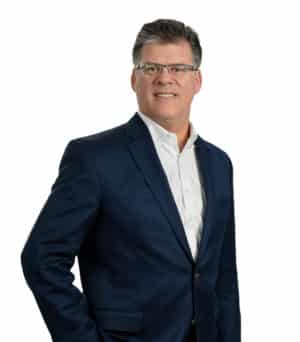Wayne Patenaude
President and CEO, Cambridge Savings Bank
Age: 62
Industry experience: 40 years
Cambridge Savings Bank President and CEO Wayne Patenaude sees banking as being in his DNA. His father was a bank president in the 1960s, and two of his brothers have worked in banking as well. After studying finance at the University of Connecticut, Patenaude joined the industry 40 years ago and spent the first half of his banking career in Connecticut before moving to Massachusetts. He will soon mark 10 years as Cambridge Savings Bank’s leader.
Cambridge Savings Bank has 18 branches, and Patenaude said the bank plans to open two or three more branches during the next three years. The bank last year also launched a digital bank, Ivy Bank, open to most U.S. residents.
Q: What’s your perspective on your past 10 years leading Cambridge Savings Bank?
A: It’s been a great run. We’ve grown to just over $6 billion in assets as of today. That growth represents about two-and-a-half times where we were when I took over at the beginning of 2013. Earnings are up three times. We’re also very proud that our corporate giving to the communities we serve is up nearly three times as well. We’ve targeted 6 percent-plus of our earnings each year to donate to the communities we serve.
The business has changed a lot, particularly in the last five years. I like to say that the business has changed more in five years than it did in the prior 50. We’ve seen the advent of the digital channel becoming more and more popular with consumers, as well as the use of various tools, like data analytics, to help us understand our customers better. Of course, more recently, we faced challenges with COVID. The bank did a really nice job serving the three constituents that we’re very proud to serve, which are our customers, our employees and the communities that that we operate in.
Q: What have been some of the keys to growing to $6 billion in assets?
A: I started here as the chief financial officer in 2007, and in 2006, my predecessor, Bob Wilson, and the board, made a very good decision to get into commercial banking. In our 188-year history, the last 15 years have been developing that commercial line of business, both commercial real estate lending and what we call corporate lending – more popularly known as C&I lending. Now those business lines represent about $3.5 billion of our assets. When the business was started, we had about 75 percent of our assets in consumer-type loans, and now that’s basically flipped around. So, we’re more of a commercial bank, even though we have “savings” in our name. It’s not that these other business lines aren’t important to us. They certainly are, and they are doing well.
Q: What was the driver behind launching a digital bank?
A: When we started thinking about it, we were looking for a different channel to provide funding for our growth and also recognizing how this digital channel was becoming more the channel of choice for consumers and even for business customers. We wanted a channel to not only give us a broader reach for generating funding, which is outside the Massachusetts market in general, but also a way for us to really understand the types of products and services that customers need and will want as they go through their journey through their financial lifecycle.
Q: How else does having Ivy Bank benefit Cambridge Savings Bank?
A: It’s a way for us to test and learn what customers want to get out of their banking relationship and out of the digital channels. For example, we just put in two tools we think are important to the customer: a credit score tool and a money management tool. Out of the customer base we have with Ivy, 31 percent have adopted the credit score tool and 40 percent have adopted the money management tool. These tools are also being adopted into Cambridge Savings Bank’s other channels.
Q: Do you see Cambridge Savings Bank as being able to retain its status as a mutual bank?
A: Absolutely. We have organic growth targeted in our strategy of about 6 percent to 10 percent a year, and we’ve been doing within that range over the last 10 years. With the earnings generation that we’ve been able to achieve, we can grow comfortably and keep our capital levels where they need to be – which is certainly well more than adequate – and be able to do the things that are important to those three constituents: the consumer, the employee and the communities we serve. We don’t have that fourth constituent, which is shareholders. We can make decisions now, invest in those constituents and be able to provide a real strong institution for the next 188 years. It’s a big commitment from our board and the management of the organization, and I think financially we can do that and grow and earn what we need to earn to remain relevant.
Q: Will mergers and acquisitions be part of your future growth?
A: That is a possibility. What we like to say in regards to our M&A strategy is that it’s a little bit opportunistic. Meaning that the industry has shrunk over the last several years, so there’s just not the opportunity to acquire another institution or merge with an institution. We are an organization that does look at that as an opportunity to accelerate our growth, and we will consider that as opportunities become available.
As part of the strategy of M&A when there are other acquisitions in the market, we’ve been able to pick up some really strong talent. A great example of that is the asset-based lending team that we brought over from an organization that had merged about four years ago. The growth has been terrific, and that business has been very profitable for us.
Patenaude’s Five Favorite Books
- “Sapiens: A Brief History of Humankind” by Yuval Noah Harari
- “Amazing Grace” by Dean J. Patenaude, Wayne Patenaude’s brother
- “Devotion: An Epic Story of Heroism, Friendship, and Sacrifice” by Adam Makos
- “Seven Summits” by Dick Bass, Frank Wells and Rick Ridgeway
- “The Wave: In Pursuit of the Rogues, Freaks, and Giants of the Ocean” by Susan Casey







